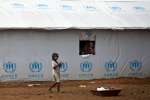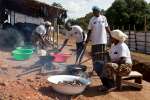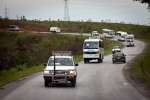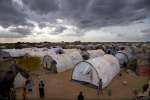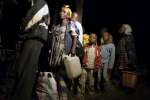Home > Where We Work > Africa > Southern Africa > Angola
2015 UNHCR subregional operations profile - Southern Africa
| Overview |
Southern Africa currently hosts more than half a million people of concern. At the end of 2013, they included approximately 136,000 refugees, 278,000 asylum-seekers and nearly 1,700 returnees.
Elections held during 2014 in Madagascar, Malawi, and South Africa were peaceful. In Botswana, Namibia and Mozambique, elections are expected during the remaining months of 2014. In Mozambique, discord between the main political parties caused some population movement, but a peace agreement was signed in August 2014. Reports of civil unrest related to the economic crisis continue in Malawi, South Africa and Swaziland.
Governments in the region are concerned about national security, trafficking, human smuggling and abuse of the asylum system, resulting in stricter border controls. National asylum systems in these countries are severely stretched and identifying people in need of international protection is difficult. While nearly all subregional countries are party to the 1951 Refugee Convention, its 1967 Protocol, and the 1969 OAU Convention, most have signed with reservations regarding freedom of movement and employment access. Nearly all the countries, with the exception of Angola and South Africa, have encampment policies that restrict freedom of movement and limit possibilities for self-reliance.
UNHCR supports voluntary repatriation, particularly to Burundi and Rwanda, when conditions are conducive for return. Most governments are also reluctant to offer local integration opportunities, though Namibia, South Africa and Zambia have agreed to locally integrate former Angolan refugees who meet specific criteria. This process is expected to be complete by the end of 2016. Resettlement continues to be an important and effective durable solution in the subregion.
Attacks on foreign-owned businesses continue in South Africa, where most refugees live in urban areas. Similarly, public and official support for refugees has deteriorated in other countries such as Angola, Botswana and Malawi.
People at risk of statelessness in the subregion remain a concern. Botswana, Lesotho, Malawi, Mozambique, Swaziland, Zambia, and Zimbabwe have signed the 1954 Convention relating to the Status of Stateless Persons. The 1961 Convention on the Reduction of Statelessness has been signed only by Lesotho, Mozambique and Swaziland. People at risk of statelessness are found mainly in Madagascar, Malawi, Mozambique, South Africa and Zimbabwe, but exact numbers are unknown.
| Response and implementation |
With a budget of more than USD 25 million, the South Africa operation is presented in a separate country chapter. For other UNHCR operations in this subregion, please see below.
According to government data, more than 20,000 asylum-seekers and nearly 24,000 refugees reside in Angola. UNHCR will continue working with the authorities to strengthen national refugee legislation and reinforce the country's refugee status determination (RSD) capacity. It will promote policies and standards for the admission of asylum-seekers, including those who arrive within broader migration flows.
The Office will advocate for durable solutions, including facilitating or promoting voluntary repatriation to Burundi, Liberia, Rwanda and Sierra Leone.
UNHCR will also continue to work with the Government of Angola on solutions for the more than 80,000 former Angolan refugees remaining mostly in the Democratic Republic of the Congo (DRC), Namibia and Zambia.
Following the repatriation of Angolan refugees, Botswana's refugee and asylum-seeking population has decreased to approximately 3,000 people, most being from the DRC, Namibia, Somalia and Zimbabwe. The encampment policy is strictly enforced; refugees found outside the camp without valid permits can be detained for long periods. This has contributed to create social problems, including survival sex, sexual and gender-based violence (SGBV), high education dropout rates and substance abuse.
Legislative reform remains a priority for Botswana. The Government has established a working group to review the Refugees Control and Recognition Act of 1967. UNHCR will advocate the country lifting its reservations to the 1951 Refugee Convention and intensify efforts to persuade the authorities to find alternatives to detention. Voluntary repatriation for Namibians and Zimbabweans will be pursued.
The Indian Ocean island States of Comoros, Seychelles and Mauritius do not receive many refugees. UNHCR periodically monitors these countries and tries to find durable solutions quickly when new arrivals are reported. The Office will support the small population of refugees and asylum-seekers in Madagascar and continues working with the Government and civil society to address statelessness.
In Lesotho, there are 30 largely self-reliant refugees and asylum-seekers. UNHCR continues to advocate unconditional citizenship for those refugees who have been in the country for five years or more, in accordance with existing national legislation.
Some 17,000 refugees and asylum-seekers in Malawi mainly originate from Burundi, the DRC and Rwanda. UNHCR will continue supporting the Government of Malawi's RSD process and advocating both the lifting of reservations to the 1951 Refugee Convention and the introduction of a new refugee policy. The Office will endeavour to ensure basic needs of refugees living in Dzaleka camp are met, including food, education and health care. With the local community, UNHCR will run activities to prevent SGBV. To increase individuals' self-sufficiency, training and seed money will be provided to kick-start small-scale businesses. The Office will continue promoting voluntary repatriation when possible and pursue resettlement for refugees who meet the criteria.
A 2013 report warned that a number of people were at risk of statelessness in Malawi. UNHCR will support government efforts to identify and appropriately respond to this by providing training and capacity building.
Mozambique hosts 4,462 refugees and 11,478 asylum-seekers, the majority of whom originate from Burundi, the DRC, Rwanda and Somalia. Of these, 8,475 live in Maratane camp, the country's only refugee camp, where basic services and assistance are provided by line ministries, with substantial UNHCR funding. In partnership with WFP, food distribution is facilitated by UNHCR and implemented by other partners. In 2015, UNHCR, with WFP, will consider transitioning to cash and voucher assistance there.
As Mozambique is a route for mixed migration southwards, UNHCR is involved in reinforcing border-monitoring systems and referral mechanisms in a more protection-sensitive manner, with IOM and the Government. The authorities' flexible approach regarding freedom of movement allows people of concern to enjoy work opportunities or study outside the camp, with 47 per cent of the total population settled in urban centres.
UNHCR will advocate: a more conducive environment for local integration; accession to the two UN Statelessness Conventions, following a pledge made by Mozambique in 2011; and the lifting of reservations made to the 1951 Refugee Convention. Mozambique is a pilot country of the Delivering as One framework, underpinning opportunities for UNHCR to implement programmes with other UN agencies.
In Namibia, there are 3,494 refugees and asylum-seekers and more than 1,700 former Angolan refugees. Nearly all reside in Osire refugee settlement. UNHCR will focus on durable solutions, particularly the local integration of former Angolan refugees and the resettlement of those refugees who remain in the camp, including those from the DRC. The Office will continue strengthening the protection environment, with a view to ensuring the Government assumes full responsibility for protection activities by mid-2015. This will allow UNHCR to phase out its presence, though it will continue supporting the Government, notably in RSD, food assistance and shelter from its regional office in Pretoria.
UNHCR also covers Swaziland from its Pretoria office. At the end of 2013, the refugee population had increased by 25 per cent to 1,045. Approximately half of these refugees are locally integrated and live in urban areas. The Government provides education, health and other services to those who remain in Malindza reception centre, with complementary UNHCR and partner support.
As of mid-2014, some 54,000 refugees and other people of concern were residing in Zambia, most in the two refugee settlements of Meheba and Mayukwayukwa. In 2015, efforts will focus on durable solutions. The Government of Zambia remains committed to honouring a December 2011 pledge to locally integrate 10,000 former Angolan refugees. To facilitate the process, new settlements have been allocated by the Government of Zambia. UNHCR will support the Government in: providing basic services; obtaining donor support for infrastructure improvement; establishing income-generating activities for these integrated communities; and advocating these areas be included in UNDAF and national development plans.
UNHCR will assist refugees through cash-based interventions, rather than food aid, and support governments in ensuring refugees' access to social services.
Zimbabwe hosts more than 8,500 refugees, mainly from the Great Lakes and the Horn of Africa, 85 per cent of whom reside in Tongogara refugee camp. UNHCR's overall protection strategy in Zimbabwe will focus on: strengthening asylum practices, particularly improving RSD; improving documentation, including birth registration; finding durable solutions, particularly through resettlement; and reducing individual protection risks, with a focus on SGBV and child protection. WFP is expected to take over the provision of food assistance, while UNHCR works on improving targeted assistance. Specific attention will be paid to lighting the camp, with a focus on sustainable energy resources.
| Financial information |
The total comprehensive budget for the subregion has been decreasing steadily since 2011's USD 93.9 million. In 2012, it was set at USD 90.5 million, and in 2013, the budget decreased again to USD 83.5 million, mainly due to a reduction in the number of Angolan refugees following application of the cessation clause and its projected budgetary implications. In 2014, the budget for Southern Africa decreased further, to USD 71.8 million, but in 2015 has been set at USD 73.5 million, particularly to support the local integration of Angolans in Zambia, as well as the growing number of new arrivals in Malawi.
| UNHCR 2015 budgets for Southern Africa (USD) | ||||
|---|---|---|---|---|
| Operation | 2014 Revised budget (as of 30 June 2014) |
2015 | ||
| Refugee programme PILLAR 1 |
Stateless programme PILLAR 2 |
Total | ||
| Total | 71,808,845 | 72,179,247 | 1,352,035 | 73,531,283 |
| Angola | 5,771,320 | 5,453,056 | 0 | 5,453,056 |
| Botswana | 5,045,678 | 4,191,907 | 0 | 4,191,907 |
| Malawi | 4,345,615 | 5,612,834 | 0 | 5,612,834 |
| Mozambique | 5,414,283 | 4,769,181 | 380,099 | 5,149,280 |
| Namibia | 3,952,101 | 546,748 | 0 | 546,748 |
| South Africa Regional Office | 26,678,041 | 26,298,812 | 971,936 | 27,270,748 |
| Zambia | 13,776,664 | 19,500,008 | 0 | 19,500,008 |
| Zimbabwe | 6,825,143 | 5,806,701 | 0 | 5,806,701 |
Source: UNHCR Global Appeal 2015 Update



